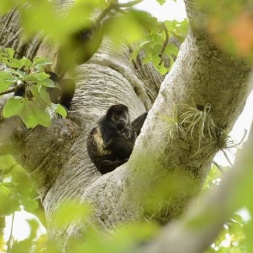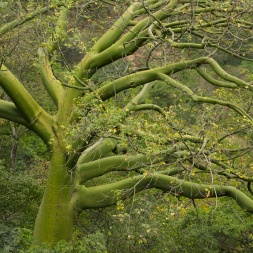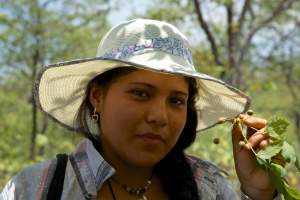Bosque Seco Biosphere Reserve
Our local team supported the creation of the 1.25 million acre UNESCO Biosphere Reserve in southwestern Ecuador, bringing global attention to the preservation of Ecuador’s most pristine dry forest.
Throughout southern Ecuador, we are helping local communities and municipalities establish reserves and placing government-owned forests under conservation management. Our work is helping to form habitat corridors that link the major areas of forest on both the Ecuadorian and Peruvian sides of this ecosystem.
 The new Bosque Seco Biosphere Reserve extends over 1.25 million acres of the country’s most pristine dry forest, home to one of the highest concentrations of endemic birds in South America and an important population of flagship species including the American crocodile and mantled howler monkey. An amazing number of species are endemic to this region, including 31 varieties of birds and 20 varieties of amphibians and reptiles. Eleven of these species are threatened by extinction and will soon vanish unless direct efforts are made to protect them. In addition, almost 20% of the plant species in the area are endemic.
The new Bosque Seco Biosphere Reserve extends over 1.25 million acres of the country’s most pristine dry forest, home to one of the highest concentrations of endemic birds in South America and an important population of flagship species including the American crocodile and mantled howler monkey. An amazing number of species are endemic to this region, including 31 varieties of birds and 20 varieties of amphibians and reptiles. Eleven of these species are threatened by extinction and will soon vanish unless direct efforts are made to protect them. In addition, almost 20% of the plant species in the area are endemic.
Unfortunately, over 95% of the region’s natural forest cover has been lost, making the protection of the remaining habitat a top priority. According to our resident botanist, Eduardo Cueva, there are several possible new plant species being discovered in this area, some of which could provide medicinal benefits to humans.
Biosphere Reserves are a significant conservation achievement because they remain under national jurisdiction but share their experience and ideas regionally and internationally within the World Network of Biosphere Reserves. Our office in Loja, Ecuador worked extensively with the national government and several non-governmental organizations to prepare the proposal for Bosque Seco, along with eight municipalities, farming communities, and school EcoClubs. In September 2013, after one year of work, the Ecuadorian government presented the proposal for the declaration of Bosque Seco, or the dry forest of Loja, as a new UNESCO Biosphere Reserve.  On June 13th, 2014, UNESCO approved the proposal and inscribed this area as Ecuador’s 6th Biosphere Reserve.
On June 13th, 2014, UNESCO approved the proposal and inscribed this area as Ecuador’s 6th Biosphere Reserve.
For the first time in Ecuador’s history, municipal and private reserves are considered it’s core conservation areas. These core areas span over 55,000 acres and include our La Ceiba, Cazaderos, and Laipuna Reserves, which we have been managing for the last decade. We are now devising a detailed conservation plan alongside the Bosque Seco Biosphere Reserve’s 100,000 inhabitants to ensure its ongoing protection. Meanwhile, we are continuing to work with the Ecuadorian government, including the Ministry of Environment, and several conservation partners to ensure connectivity between southern Ecuador’s many reserves.
A Bi-National Biosphere Reserve in the Making
A new conservation goal has been established by the Ecuadorian and Peruvian environmental authorities – the declaration of a bi-national UNESCO Biosphere Reserve. Nature & Culture, which has helped establish three out of Ecuador’s six Biosphere Reserves, will be providing technical and financial support to the Environmental Ministry of Ecuador.
This area will integrate the Bosque Seco Biosphere Reserve with Peru’s Amotapes Biosphere Reserve, which was recognized by UNESCO in 1977 and recently enlarged with the support of Nature & Culture to protect Peru’s vital mangrove ecosystem. Once completed, this bi-national Biosphere Reserve will span nearly 4 million acres.
The Palo Santo Project
In the highly endangered tropical dry forests of southern Ecuador, the Palo Santo tree provides a much needed source of income to a rural population with limited resources. For generations, harvesting the tree’s valuable oils has been accomplished through deforestation.
With the help of our regional office in Loja and a team of biologists from the Technical University of Loja, the community of Zapotillo is now harvesting the oil from the fruit of the Palo Santo tree, leaving the trees intact to grow, reproduce and renew the remaining stands of tropical dry forest.
In partnership with the municipality of Zapotillo, we helped organize the Bolívar Tello Community Association to manage the Palo Santo resources and market the product to companies such as the Brazilian-based cosmetics company, Natura.
In June 2014, the Bolívar Tello Community Association was awarded the United Nations Development Programme’s Equator Prize for the Palo Santo project’s outstanding effectiveness and ability to reduce poverty through the conservation and sustainable business practices.



